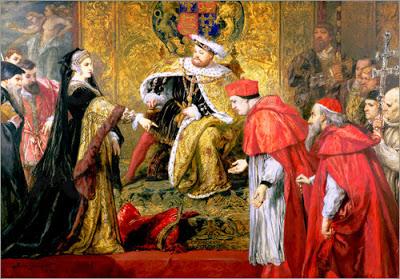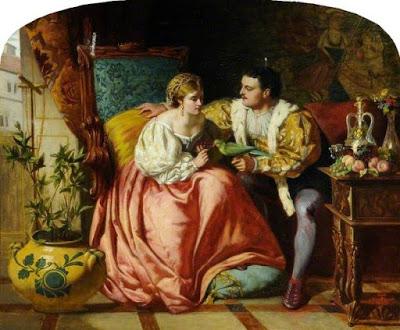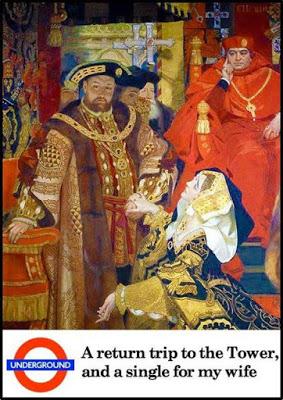
Head of a Tudor Girl Eleanor Fortescue Brickdale
The Victorians loved to reinterpret the past through art, and often their historical painting very vividly brought to life past personalities in a way that only a bonk-fest costume drama can manage these days. They also loved the pattern and splendour of fabrics of different eras, such as the jewelled hood this little Tudor girl is wearing in the picture above. Pearls and jewels sparkle around her square neckline and her sleeves are capped with fur as she clutches a small dianthus, denoting love of a mother, or possibly sorrow at a death (or maybe a combination of both, looking at the slightly sorrowful expression on her face).
'With All Their Banners Bravely Spread' (1878) John Gilbert
The great, gouty love-god of the Tudor period is of course Henry VIII and I was a little dubious as to what the Victorian attitude to him would be. After all, he wasn't exactly morally untouchable and there was quite a bit of head-removal and Pope-bothering going on. I shouldn't have worried though because to the Victorian artist, Henry VIII meant two things: one massive battle (which he wasn't present at, ironically) and loads of romance. The Battle of Flodden Field in 1513, pictured above, gave the artists an opportunity to show horses, armour, lovely colourful standards and a bit of a scrap. The pathos of a dead Scottish king (the last monarch to die in battle) must have played into the hands of the Victorians who loved all things tartan. Walter Scott rhapsodised about it in Marmion, making it a sure-fire winner for the public.
The Battle of Flodden Field (1878-1883) Edward Burne-Jones
Burne-Jones gouache study for a low-relief plaque in Naworth Castle reminds me of Uccello's The Hunt in the Forest, but also has strangely Futurist foreshadowing at the same time. I am struck by all those lines, banners, spears and bodies and the horses bravely charging on into the inhuman madness of war. However, I think if Scott hadn't bothered to mention it, the Victorians might not have found it of interest. To be fair, if you asked anyone today what they thought of when you say the name 'Henry VIII' they probably would say 'wives'...

Henry VIII and Catherine of Aragon before Papal Legates, 1529
(1910) Frank O Salisbury

Catherine of Aragon (1866) William Bromley
Poor old Catherine, endlessly followed around by chaps in red. The one on the right is Cardinal Wolsey, Lord Chancellor and his friend (who has embarrassingly turned up tot he party in the same frock) is the Papal Legate, Cardinal Campeggio, and as always Catherine is telling them to talk to the hand.
Queen Catherine and the Cardinals (1870) John Gilbert
To be fair, the Cardinals are fairly obvious in their red so she can spot them easily. Gilbert shows her giving the Cardinals what-for, much in keeping with what a strong woman she was, which is often lost in her portrayal of the inconvenient wife in the Henry/Anne love story. Talking of which...

Henry VIII First Interview with Anne Boleyn (1835) Daniel Maclise
Of course, poor Catherine's struggles with her marital dilemma is only a side issue when it comes to the main event in Tudor romantic history. I'm not sure exactly what it is about the affair between Anne Boleyn and Henry, but of all his wives, she is the one people remember and claim they are the reincarnation of. Come on, no-one ever claims they are the reincarnation of Anne of Cleves. Or whoever Joan Sims was in Carry On Henry (source of most of my Tudor knowledge up to this point). Anyway, Henry VIII is not depicted in these paintings as some desperate son-seeker, rather your average massive monarch who has been hit by cupid's arrow (Lord knows he makes a big enough target)...

Henry VIII and Anne Boleyn (1903) William Powell Frith
It is unsurprising that the Victorians were interested in Anne Boleyn. In 1876, during renovations of the Chapel of St Peter ad Vincula, her body was found and subsequently reburied, and her ghost was seen gliding around at the Tower of London (I didn't realize about that aspect of Victorian Tudor interest until I read The Arrow Chest). The romance and fatal break-up is both heart-swelling and heart-wrenching and marvellously melodramatic. One minute he's changing the whole nature of religious life in the country for you, the next, he's lopping your head off. Such is love...
Henry VIII and Anne Boleyn (1865) David Wilkie Wynfield
Still, I suppose proper love stories in royalty were a bit of a rarity, and the love affair between Henry and Anne sort of mirrored that between Victoria and Albert. Both couples just fell in love with no thought to how politically it would benefit them. Well, that's the story anyway. Certainly in Henry's case it was rather inconvenient to be in love with another woman who wasn't the widow of your dead brother and your current wife, especially in hindsight, without a male heir to justify the whole business. Still, those sweet, heady days of early courtly love, the wooing, the gifts, the flirtatious glances and fluctuating weight and facial hair. Sigh.

The Arrest of Anne Boleyn at Greenwich (1872) David Wilkie Wynfield
Then it all goes wrong and people get arrested and accused of all sorts of stuff. I find the images of Anne Boleyn filled with righteous fear and anger very similar to her predecessor, which possibly is the point and does rather fall into the 'what comes around, goes around' category. However, with Anne the stakes were higher and it wasn't just divorce that was on the cards; because variety is the spice of life, it was something rather more choppy...
Anne Boleyn on the Queen's Stairs (1871) Edward Matthew Ward
There are interesting similarities in the way Victorian artists portrayed doomed queens, from Lady Jane Grey to Mary Queen of Scots and here we have Anne, pausing for a fainty breather on her way into the Tower and imprisonment and eventual chopping. There is no need to ask how Ward sees Anne, as she glows in her innocence surrounded by accusers and rubber-neckers. She is a martyr, Love's own sacrifice and she holds the power to stir pity and empathy in her plight. Is her pause up the stairs meant to reflect Christ off to Calvary? The boat is casting off again and she will not be leaving.
Poster from German film Anna Boleyn (1920)
It is interesting in Victorian art to see the changes between how Henry is portrayed in his romance with Anne. Sometimes he is the iconic, huge monarch slinging chicken legs over his shoulder, but often he is the young, handsome hero, lithe and manly. Interestingly we seem to have moved away from the bearded older man (as played by Emil Jannings in the above film, but also see Keith Michell, Charles Laughton and James Robertson Justice in their portrayals. Considering now that it is obligatory to have some naked business in our costume dramas, King Henry has stopped being gouty and started being gorgeous, with Eric Bana, Jonathan Rhys Meyers and Damien Lewis all shedding the weight and upping the sexiness. As I have discussed in reference to cultural depictions of Rossetti, we obviously can't cope with a man who is both older, fatter and yet still devastatingly attractive to women.
Probably not a real poster for the Underground. Probably.
Much in the same way as people in loving stable relationships vicariously live the other side of the coin through Jeremy Kyle, the Victorian public took to the Tumultuous Tudors safe in the belief that none of those sorts of shenanigans were about to go on with Good Queen Vickie. It strikes me that the Victorians loved to be emotional tourists in all the things they disapproved of, and they also found romance in tragedy. No wonder they grasped hold of Anne Boleyn, first immortalised for the nineteenth century public in the Gaetano Donizetti opera 'Anna Bolena' of 1830, and wouldn't let her go. She remained a sympathetic figure, almost exclusively because of her death, yet modern portrayals of her have her as more scheming, more calculating. For the Victorians, she was as innocent as Queen Catherine before her, both defeated by their love for a monarch who was ruled too much by his heart.Well, maybe not his heart.

